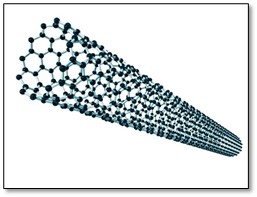Vantablack: The blackest black
Do you know that the vantablack holds a world record of the darkest man-made material?
YES, it is. So, it’s quite fascinating to learn about its extraordinary properties, applications, and how it’s made, isn’t it?
Meet Vantablack here. It is the darkest material, a ‘Byronic black’ and it absorbs almost all visible light. It may be viewed as a super-black coating made of ‘n’ number of carbon nanotubes!
Image Source: https://www.cnet.com/pictures/vantablack-swallows-everything-its-painted-on/
Image: Tourists Fell into This Ultra-Black Artwork That Looks Like a Cartoon Hole
Image Source: https://www.sciencealert.com/somebody-actually-fell-into-ultra-black-artwork- looks-fake-hole-vantablack-anish-kapoor
History:
It was invented in 2014 in the United Kingdom by British company Surrey Nanosystems. This name is an acronym of Vertically Aligned Nano Tube Array Black.
It was originally developed for space applications and for optical systems like telescopes. For example, coating telescopes with this material can lessen the glare by absorption of unnecessary light so that a person can see distant objects more clearly.
After vantablack was commercially made available as a service from Surrey NanoSystems since 2014.
In 2016 artist Mr. Anish Kapoor made a deal with Surrey Nanosystems and obtained rights for use of this ‘pigment’. His first application of this pigment cum material could be viewed in his large sculpture Cloud Gate in Chicago.
Image Source: https://www.wired.com/story/vantablack-anish-kapoor-stuart-semple/
Structure and Properties:
Basically, vantablack is not a continuous fluid substance, it is a forest of carbon nanotubes approximately of height 14-20 nm and width of 20 nm. These are way smaller than our hair about 3500 times… Newer versions of Vantablack use different arrangements of CNT’s.
So, it is actually seen as a coating that utilizes nanotubes made of pure carbon (CNT’s) generally aligned in a vertical fashion.
But what does exactly makes the vantablack the blackest of all?
It’s a simple phenomenon. As light interacts with the vantablack, instead of reflecting, it gets trapped and continuously deflected among the vertical tubes. Ultimately the light is absorbed and dissipates in the form of heat and we can experience the darkest vantablack.
Let’s move to its characteristics!!
It can absorb around 99.96 % (almost all!) light falling on it (and we know its consequence: it appears as a black void). It can also absorb light from UV to far-infrared spectrum. This to a very clean and uniform absorption, from all angles.
Its THR (Total Hemispherical Reflectance) i.e., measurement of the reflectance of light scattered off at all angles of the sample, is less than 1.5%.
Its particle fallout level and outgassing levels are comparatively low while the resistance to mechanical vibrations is high. Additionally, they are superhydrophobic.
Image: SEM of a VANTA coating grown on an aluminum substrate after it was subjected to the space qualification tests.
Interesting Applications:
· The vantablack was initially developed for satellites to absorb the sun's light (solar energy) and the heat energy is then converted from that light energy, which is used for power electronics and to heat water on a spacecraft. Similar execution of its absorption property is found in military application i.e., thermal camouflage.
· It's remarkable ability of absorption also makes it useful in various high-performance IR cameras, sensors, telescopes, and other scientific instruments to help in the reduction of unwanted stray light also to improve the visibility of distant objects for study.
· It is utilized by designers and artists.
· Vantablack coatings is its popular application. These are sprayable paints with randomly oriented nanotubes.
There are three types of vantablack coatings of different variants listed below:
1. Vantablack S-VIS (UV-THz performance - space qualified)
2. Vantablack S-IR (Optimised from 5-14um - space-qualified for blackbody applications)
3. Vantablack VBx2 (Terrestrial applications from UV-THz)
BMW produced the first-ever vantablack coated car. It used Vantablack variant VBx2 to coat the car BMW X6 SUV (The world’s Blackest Car)
Image: Coating of BMW X6 SUV by using VBx2,
Image Source: https://www.bmwblog.com/2019/08/27/bmw-vbx6-vantablack-the- worlds-blackest-black/
Image Source: https://www.bmwblog.com/2021/04/28/a-final-look-at-the-bmw-x6- vantablack-the-darkest-color-in-the-world/
In a nutshell, vantablack has applications in deep space imaging, automotive sensing, optical systems, art, and aesthetics.
Apart from the above-listed applications, is there anything else, more fascinating application coming to your mind? Let us know.
Know about some recent developments here...
The vantablack coatings can be applied at high temperatures with a special reactor. But now due to recent developments in the arrangement of carbon nanotubes, they can be directly sprayed onto the surface using special apparatus. This made vantablack more versatile!!!!
However, there is one amazing fact that MIT engineers have made a material of vertically aligned carbon nanotube (CNT) grown on chlorine etched Al foil which can absorb 99.995% visible light.
The blackest of all, even darker than vantablack!!!
Blog Credits:
Chetaneshwari Nivargi (111911009, TY Metallurgy)
Madhura Mahamuni (111911024, TY Metallurgy)
References:
https://www.dezeen.com/2019/09/24/blackest-black-mit-material-news-vantablack/
https://colourlex.com/project/vantablack/
https://www.thecollector.com/vantablack-anish-kapoor-stuart-semple-controversy/
https://science.howstuffworks.com/vantablack.htm
https://www.surreynanosystems.com/about/vantablack
https://www.bmw.com/en/design/the-bmw-X6-vantablack-car.html
https://www.dezeen.com/2019/09/24/blackest-black-mit-material-news-vantablack/
https://colourlex.com/project/vantablack/
https://science.howstuffworks.com/vantablack.htm
https://www.scienceabc.com/innovation/what-is-vantablack.html
https://www.researchgate.net/publication/339796921_Vantablack
NOTE:-
This blog is meant for educational purposes only. We do not own any Copyrights related to images and information, all the rights go to their respective owners. The sole purpose of this blog is to Educate, Inspire, Empower, and create awareness in the viewers. The usage is non-commercial(Not For Profit) and we do not make any money from it.
Write your feedback here:
https://forms.gle/C3ybXMPPUaJBgP618
FOLLOW US ON:-
INSTAGRAM :
https://bit.ly/coep_blogs_insta
LINKEDIN:
https://bit.ly/coep_blogs_linkedIn
YOUTUBE:-










Comments
Post a Comment